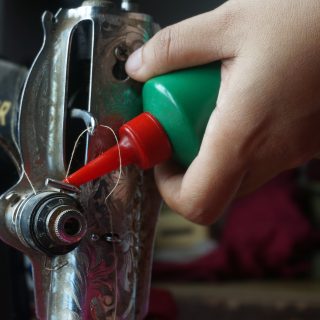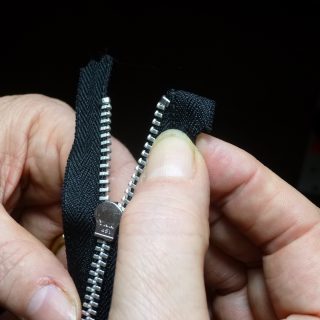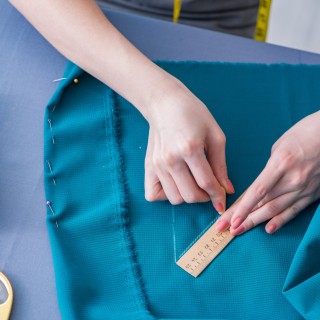Sewing bags, coats, jackets, shoes, or hats for example, usually requires thicker materials such as leather, wool, canvas, rexine, etc. If you’ve already tried making these, you know how difficult it can be to pass a needle through them.
Yet, you always want to add cool closures, handles, belts, or other accessories to your sewing project.
Well, what if I told you that it’s possible to stitch thick materials with more ease?
Enter the sewing awl.
What Is a Sewing Awl?
Many people, some of them being experienced sewists, haven’t heard of the sewing awl. That’s why I will first explain what this tool is, before jumping to the step-by-step tutorial.
A sewing awl, also known as a stitching awl, is a sewing tool used to puncture various types of materials or for enlarging existing holes.
A sewing awl is a metal shaft on a wooden handle. There are two types of usually interchangeable needles, one straight, and the other slightly bent. On the sharp top of the needle, there is usually a needle eye making thread drawing through the holes for manual lockstitch sewing easier.
Leatherwork usually requires stitching, so shoemakers and repairers call this tool a stitching awl, while those using it to work with other materials usually use it to make lockstitches, and call it a sewing awl.
This useful tool also has its place in history that is less known. When he was a child, a four-year-old Louis Braille, accidentally hurt his eye with an awl. He became blind only on one eye, but soon, the infection also caught the other eye leaving him without vision early in life.
This diversity spurred Braille into inventing the Braille alphabet, and its prototype was made using an awl (the guy just wouldn’t give up no matter the price)!
What Can I Use a Sewing Awl For?
Sewing awls have been in use since the 18th century for puncturing holes, stitching, and sewing thick materials.
However, its use is not limited to these, as you can use a sewing awl for your car interior, furniture, scrapbook, notebook registers, etc. You can even use it to make your own notebooks and document registers by stacking up some paper, piercing them with a threaded awl, and then tying the thread and binding your notebook.
With a sewing awl, you can also make your own belt, mend a tent or a sail, repair your athletic gear, fix your shoes, stitch and fix your home upholstery, etc.
Sewing Awl – Parts
Now, let’s take a closer look into a sewing awl’s parts, so you can understand better how to handle it.
Wooden Handle
Every good sewing awl has a wooden handle that allows you to have a good grip and apply pressure to the fabric. Most older models of awls have tiny storage for a bobbin size reel/thread spool that would move alongside the needle.
Bobbin Size Reel
Bobbin size reel is a piece of thread you need to manually wrap the bobbin. As you do this, you should be very careful and neat, as you want your bobbin size reel to fit into the tiny storage on the handle.
Chuck
The chuck is placed between the needle and the handle of the sewing awl. Its purpose is to replace the needle in the right spot so it remains unscrewed.
Needle
Finally, the needle. The needle on the sewing awl is attached firmly to the handle. There are two types of needles you can use for an awl: the straight ones and those that are curved and bent down a bit.
Awl needles have sharp tips that make piercing thick materials so much easier.
Thread to Use for a Sewing Awl
The type of thread you’ll use for your sewing awl mostly depends on the material being sewn. Sewing leather fabric with a cotton thread simply won’t do.
The most common type of thread used on sewing awls is nylon thread, or in case you’re sewing leather or Rexine, you can also use waxed thread intended for these materials. The plus side of using a wax-coated thread is that it simply glides through the material being sewn without knotting, which can be super-helpful when you’re working with heavy-duty, thick fabrics.
How to Use a Sewing Awl Step by Step Guide
Now that you’ve found out what a sewing awl is and that you’re more familiar with its parts, you are ready to learn how to use it. If you have a brand new sewing awl and you’re just looking for a way to use it, it may have arrived to you pre-threaded. In that case, you can simply start working and skip all the steps that refer to threading your sewing awl.
You can also change the thread in the awl in case you want to work with a different color, or you need a heavier/lighter thread. To do this, you don’t need to unwrap the entire bobbin (whew!), you can only unwrap a bit to free up room on the bobbin, and just wind on the other thread you want to use. Just make sure to put enough of the other thread for your entire project.
Preparing the Sewing Awl: Thread and Needle
Step 1
The thread is usually located at the button of the handle. To access the bobbin, you will need to pull out the cap also located at the end.
Step 2
Pull and unwind the amount of thread necessary for you to complete your project and add a couple of inches extra.
Step 3
Use the thread you’ve pulled to wrap it around the tack on the handle once to create tension as you sew.
Step 4
Pick a needle you want to use for your sewing project. Insert the needle into the post and push it all the way in. Thread your needle and guide it via a small groove on the handle top.
Step 5
Put the chuck-lock on and screw in for safety.
Stitching: Pinching, Pulling, Looping
- Begin stitching from the backside of the material by pushing the needle so it comes out on the front side.
- Draw the thread out on the front side to its full length (the length necessary to complete your project + a couple of inches).
- Place the thread over the handle and hold them firmly with your thumb. Pull the needle back through the hole you just made and start making a second hole.
- Pass the needle through the second hole as far as possible.
- Pull back a little bit to form a loop.
- Pull all of your thread through this loop.
- Hold the thread at the end and make it tight.
- Pass the needle outside of the hole and form a lock-stitch.
- Pull tight and the lockstitch should be placed in the middle of the layers of the fabric.
- Release thread between the material and the needle so you can form the next stitch.
- Keep repeating these 10 steps until your finish the project.
- When you reach the last hole on your project, pull the thread out.
- Cut it so you leave enough inches to tie a knot.
- Tie the knot on the backside and cut the excess thread.
- Remove the needle from the post and place it into the adequate slot. Screw the chuck back in and leave the awl waiting for the next sewing project!
Best Sewing Awls and Awl Threads on Amazon
In case you don’t yet own a sewing awl, but you’ve figured out that you need one, here are some of the awls I’ve been using over the past couple of years that have worked just fine for me.
The Speedy Stitcher
The Speedy Stitcher made by Dritz is the absolute champ among the sewing awls. It’s not expensive, it’s good quality, and I’ve been using it for years now.The awl comes with a bobbin with preloaded thread in the handle making it easier for you to start a new project immediately.
If you want to change the thread or the needle, just scroll up for our simple tutorial on how to do it.
Awl for All
The Awl for All sewing awl is another well-designed tool, slightly pricier than the Dritz. The reason for this is that you get some additional parts: 5 needles of different shapes and sizes, replacement thread spools in white, brown, and black color.Jayzod Sewing Awl – Kit
This is another great-quality awl that also comes with some additional parts you may find useful: 3 rolls of waxed thread in black, white, and beige color, a screwdriver for adjusting the awl, and four needles, some fine some curved.
Speedy Stitcher W70 Thread
This brown thick thread fits the speedy stitcher sewing awl perfectly. It’s a fine polyester yarn Manufactured by Silver Creek Leather.
NYKKOLA Waxed Leather Thread
is one of the best leather threads you’ll find on Amazon for the price. The spool is 853 ft long, which should be enough for several sewing awl projects.You can find it in black, but also in brown, white, beige, and dark brown color.
FEPITO Waxed Leather Threads 8 Spools
This kit is quite cheap and it comes with very good waxed leather cords in 8 colors, however, the sewing and piercing tools coming with it are not the best quality. I would recommend purchasing the awl and sewing thimble if needed as separate products.In the package, you will also get 2 needles in a triangle shape and 1 tape measure.
SIMPZIA Leather Craft Tools
The SIMPZIA kit is another kit that comes with several tools. The sewing awl that comes with the kit is not the best quality you find, but the needles, waxed leather threads, thimble, and tape measure are pretty good.
Conclusion
I’ve shared with you everything I know about using a sewing awl. I hope you are ready to start your project now.
Sewing awls are irreplaceable tools for thick material sewing projects. If you want to fix a bag, shoes, or even your camping gear, you can count on a good sewing awl.
If you invest enough time in preparing your sewing awl, the stitching process will be much easier to handle.
Although the stitching technique differs from the regular needle stitching to some extent, with some effort I am sure you’ll get a grasp of it in no time!
Thank you for reading this tutorial. For more similar content, feel free to pay a visit to our website, and learn more about sewing projects for beginners, threading a needle on a sewing machine, or quilting without a hoop.
Last update on 2025-04-23 / Affiliate links / Images from Amazon Product Advertising API





